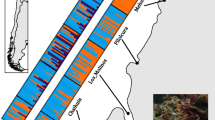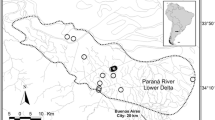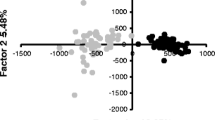Abstract
Samples of Siphonaria sp. were collected between 1978 and 1982 from sites covering its known geographic range, from Kalbarri, Western Australia to Port Robe, South Australia. Geographic variation of 7 polymorphic enzymes was examined in this intertidal pulmonate limpet, and was found to be consistently small, indicating a large-scale influence of gene flow due to planktonic dispersal. Despite this large-scale uniformity, there is fine-scale genetic patchiness, which is repeated, rather than accumulated, on the larger scale. Throughout its geographic range, Siphonaria sp. shows deficits of heterozygotes for all 7 loci. The consistency among loci indicates that the causes of the deficits are populational, rather than locus-specific. A Wahlund effect, the departure from Hardy-Weinberg equilibrium due to mixing of individuals from groups with different allelic frequencies, is the simplest explanation of such deficits. The limited geographic variation of allelic frequencies, however, is grossly inadequate to produce these deficits through a Wahlund effect. Similarly, temporal variation in allelic frequencies in recruits does not explain the deficits. The largest contributor to a Wahlund effect appears to be binomial sampling variance among small local breeding groups. Thus, mixing of larvae on a scale of metres, rather than among geographical areas, apparently produces the deficits of heterozygotes.
Similar content being viewed by others
Literature cited
Berger, E.: Gene-enzyme variation in three sympatric species of Littorina. Biol. Bull. mar. biol. Lab., Woods Hole 145, 83–90 (1973)
Black, R. and M. S. Johnson: Genetic differentiation independent of intertidal gradients in the pulmonate limpet Siphonaria kurracheensis. Mar. Biol. 64, 79–84 (1981)
Colgan, D. J.: Spatial and temporal variation in the genotypic frequencies of the mussel Brachidontes rostratus. Heredity, Lond. 46, 197–208 (1981)
Curie-Cohen, M.: Estimates of inbreeding in a natural population: a comparison of sampling properties. Genetic, Austin, Tex. 100, 339–358 (1982)
Doyle, R. W.: Choosing between darkness and light: the ecological genetics of photic behaviour in the planktonic larvae of Spirorbis borealis. Mar. Biol. 25, 311–317 (1974)
Flowerdew, M. W. and D. J. Crisp: Allelic esterase isozymes, their variation with season, position on the shore and state of development in the cirripede Balanus balanoides. Mar. Biol. 35, 319–325 (1976)
Giesel, J. T.: On the maintenance of a shell pattern and behaviour polymorphism in Acmaea digitalis, a limpet. Evolution, Lawrence, Kansas 24, 98–119 (1970)
Johnson, M. S. and R. Black: Chaotic genetic patchiness in an intertidal limpet, Siphonaria sp. Mar. Biol. 70, 157–164 (1982)
Kirby, G. C.: Heterozygote frequencies in small subpopulations. Theor. Popul. Biol. 8, 31–48 (1975)
Koehn, R. K., R. Milkman and J. B. Mitton: Population genetics of marine pelecypods. IV. Selection, migration and genetic differentiation in the blue mussel Mytilus edulis. Evolution, Lawrence, Kansas 30, 2–32 (1976)
Koehn, R. K. and J. B. Mitton: Population genetics of marine pelecypods. I. Ecological heterogeneity and evolutionary strategy at an enzyme locus. Am. Nat. 106, 47–56 (1972)
Koehn, R. K., F. J. Turano and J. B. Mitton: Population genetics of marine pelecypods. II. Genetic differences in microhabitats of Modiolus demissus. Evolution, Lawrence, Kansas 27, 100–105 (1973)
Lassen, H. H. and F. J. Turano: Clinal variation and heterozygote deficit at the Lap-locus in Mytilus edulis. Mar. Biol. 49, 245–254 (1978)
Levinton, J. S. and D. L. Fundiller: An ecological and physiological approach to the study of biochemical polymorphisms. Proc. 9th Eur. mar. Biol. Symp. 165–178 (1975). (Ed. by H. Barnes. Aberdeen: Aberdeen University Press)
Levinton, J. S. and T. H. Suchanek: Geographic variation, niche breadth and genetic differentiation at different geographic scales in the mussels Mytilus californianus and M. edulis. Mar. Biol. 49, 363–375 (1978)
Lewontin, R. C. and J. Krakauer: Distribution of gene frequency as a test of the theory of the selection neutrality of polymorphisms. Genetics, Austin, Tex. 74, 175–195 (1973)
Li, C. C.: First course in population genetics, 631 pp. Pacific Grove: Boxwood Press 1976
Maxwell, J. G. H. and G. R. Cresswell: Dispersal of tropical marine fauna to the Great Australian Bight by the Leeuwin Current. Aust. J. mar. Freshwat. Res. 32, 493–500 (1981)
Murphy, P. G.: Collisella austrodigitalis sp. nov.: a sibling species of limpet (Acmaeidae) discovered by electrophoresis. Biol. Bull. mar. biol. Lab., Woods Hole 155, 193–206 (1978)
Pudovkin, A. I. and L. A. Zhivotovskii: Deficit of heterozygotes in populations of marine benthic invertebrates. Soviet J. mar. Biol. 6, 286–289 (1980)
Robertson, A.: Gene frequency distributions as a test of selective neutrality. Genetics, Austin, Tex. 81, 775–785 (1974)
Scheltema, R. S.: On the relationship between dispersal of veliger larvae and the evolution of marine prosobranch gastropods. In: Marine organisms, genetics, ecology, and evolution, pp 303–322. Ed. by B. Battaglia and J. A. Beardmore. New York: Plenum Press 1978
Suchanek, T. H.: The role of disturbance in the evolution of life history strategies in the intertidal mussels Mytilus edulis and Mytilus californianus. Oecologia (Berl.) 50, 143–152 (1981)
Tracey, M. L., N. F. Bellet and C. D. Gravem: Excess allozyme homozygosity and breeding population structure in the mussel Mytilus californianus. Mar. Biol. 32, 303–311 (1975)
Williams, G. C., R. K. Koehn and J. B. Mitton: Genetic differentiation without isolation in the American eel, Anguilla rostrata. Evolution, Lawrence, Kansas 27, 192–204 (1973)
Winans, G. A.: Geographic variation in the milkfish Chanos chanos. I. Biochemical evidence. Evolution, Lawrence, Kansas 34, 558–574 (1980)
Wright, S.: Evolution and the genetics of populations. Vol. 4 Variability within and among natural populations, 580 pp. Chicago: University of Chicago Press 1978
Author information
Authors and Affiliations
Additional information
Communicated by G. Humphrey, Sydney
Rights and permissions
About this article
Cite this article
Johnson, M.S., Black, R. The Wahlund effect and the geographical scale of variation in the intertidal limpet Siphonaria sp.. Marine Biology 79, 295–302 (1984). https://doi.org/10.1007/BF00393261
Accepted:
Issue Date:
DOI: https://doi.org/10.1007/BF00393261




